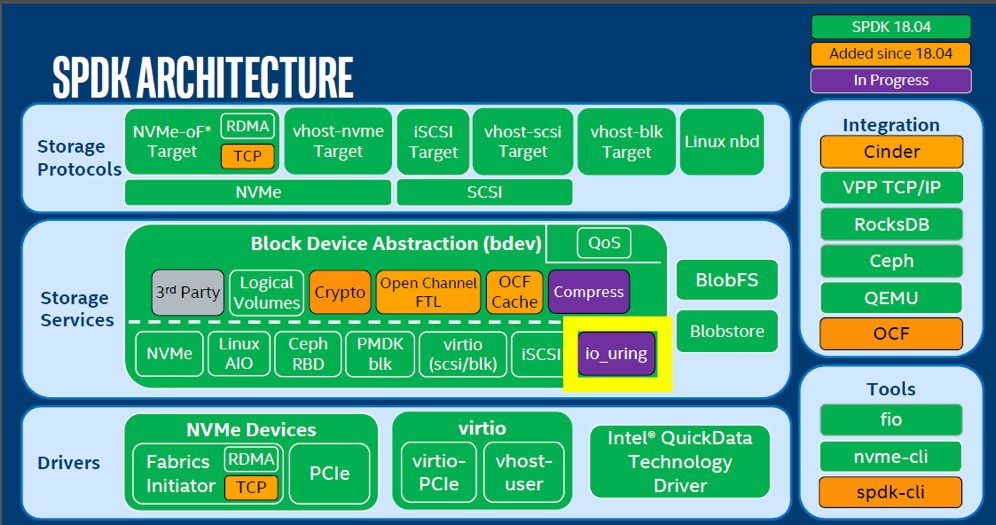introduction
With the rapid development of technologies such as big data, cloud computing and artificial intelligence, the demand for data storage has shown explosive growth. High performance, high reliability and scalability have become the important goals of modern storage systems. In this context, SPDK (Storage Performance Development Kit) came into being and became a revolutionary storage performance development kit. This article will provide a detailed overview of SPDK concepts, benefits, and future challenges.
1. Introduction to SPDK
1.1 What is SPDK? Why do I need SPDK?
SPDK, or Storage Performance Development Kit, is a set of tools and libraries for writing high-performance, scalable, user-mode storage applications. It achieves high performance through a number of key technologies, including moving all required drivers into user space, avoiding system calls and enabling zero-copy access to applications; Polling hardware to complete I/O operations reduces total latency and latency variance; Avoid all locking in the I/O path and instead rely on messaging.

1.2 Key Technologies of SPDK
As solid-state drives (SSDS), especially those based on NVMe (non-volatile memory representation), become more prevalent in data centers, the performance and efficiency of storage systems becomes critical. NVMe devices offer higher throughput and lower latency than traditional SAS or SATA drives, making them thousands of times faster than mechanical drives in terms of IOPS (input/output operations per second) and five to 10 times faster than previous SATA SSDS. However, traditional storage software stacks often become a bottleneck when dealing with these high-performance devices because the software's time consumption in IO transactions is excessive relative to the performance of NVMe devices.
SPDK (Storage Performance Development Kit) is designed to solve this problem. It avoids performance bottlenecks in traditional storage systems by implementing driver and I/O processing in user space. SPDK features include:
User-space drivers: SPDK improves the efficiency of I/O operations by moving drivers from kernel to user space, avoiding data copying and context switching between kernel and user states.
Asynchronous I/O processing: SPDK uses the asynchronous I/O model to process I/O requests, allowing applications to perform other tasks while waiting for I/O to complete, improving the system's concurrent processing capability.
Lock-free design: SPDK uses a lock-free design to manage shared resources, reducing competition and deadlocks in concurrent operations, and improving system stability and scalability.
Block Stack Library: SPDK provides a complete block stack library, including file system, volume manager, and block device driver, simplifying the development of storage applications.
Network storage support: SPDK supports multiple network storage protocols such as NVMe-oF, iSCSI, and vhost, allowing block storage services to be provided over networks.
Hot swap and failover: SPDK supports online hot swap and failover of storage devices, improving system reliability and availability.
Performance monitoring and Analysis tools: SPDK provides performance monitoring and analysis tools to help developers diagnose and optimize the performance of storage applications.
1.3 Application Scenarios of SPDK
SPDK supports a variety of application scenarios, such as NVMe-oF, iSCSI, and vhost servers. These servers are capable of providing disks over the network or other processes with high CPU efficiency. The goals of the SPDK can be used as an example of how to achieve high-performance storage goals, or as a basis for production deployments.
iSCSI Target: An iSCSI Target is a server that provides block storage over a network. It supports the standard iSCSI protocol, allowing clients to access remote storage over TCP/IP networks. The iSCSI Target applies to scenarios where storage resources need to be accessed over IP networks, such as cloud computing, virtualization, and remote backup.
NVMe over Fabrics (NVME-of) Target: NVME-of Target is a server used to provide NVMe storage over the network. It supports the NVME-OF protocol, which allows clients to access NVMe storage over IP networks. NVMe-oF Target is suitable for scenarios that require high-performance, low-latency storage resources, such as high-performance computing, big data processing, and cloud computing.
vhost Target: A vhost Target is a server that provides virtualized storage over a network. It supports the vhost and virtio protocols, allowing virtual machines and containers to directly access storage resources. The vhost Target applies to scenarios that require virtualized storage resources, such as cloud computing and virtualization environments.
SPDK Target: SPDK Target is a unified application that combines iSCSI, NVMe-oF, and vhost functions. It provides a high-performance, scalable storage solution for scenarios where multiple storage protocols and virtualization technologies need to be supported simultaneously.
2. Advantages of SPDK
2.1 Performance Advantages
One of the core benefits of SPDK is its significant performance improvements. By migrating drivers from kernel space to user space, SPDK effectively sidesteps the performance bottlenecks that exist in traditional storage systems. Implementing drivers in user space allows the SPDK to interact directly with the hardware, avoiding the overhead of data copying and context switching between user space and kernel space. This design not only reduces the number of system calls, but also speeds up I/O operations.
SPDK uses a polling mode to complete I/O operations rather than relying on interrupts, a strategy that reduces total latency and latency variance. In traditional storage systems, interrupt handling can introduce additional latency, while SPDK monitors device status in real time through a polling mechanism, enabling faster response times and lower latency.
In addition, SPDK's lock-free design and parallel processing mechanism are key to its performance benefits. The lock-free design eliminates lock contention in concurrent operations, thereby reducing performance bottlenecks. The parallel processing mechanism allows SPDK to handle multiple I/O requests simultaneously, greatly improving the system's concurrency capability and enabling it to efficiently handle high loads in massively parallel processing scenarios.
2.2 Reliability and Scalability
SPDK's block stack library provides a unified storage device interface, which simplifies storage management and makes it easier for developers to interact with different types of storage devices. SPDK supports a variety of storage device types, such as NVMe and virtio, which not only improves the compatibility of the system, but also enhances its scalability. Developers can easily integrate and use different types of storage devices in the SPDK environment to adapt to changing hardware environments.
The SPDK is also designed with high availability in mind. It supports hot swap and failover functions, which means that the system can continue to operate even when the storage device fails, ensuring the security of data and the continuity of the system. These features improve the reliability and availability of the SPDK system, enabling it to meet the stringent requirements of data center and enterprise applications.
2.3 Ease of Use and development efficiency
Another significant advantage of SPDK is its ease of use and development efficiency. SPDK provides a rich set of apis and libraries that provide a convenient interface for developers to quickly build high-performance storage applications without having to delve into the complexities of the underlying hardware and kernel drivers. This layer of abstraction simplifies the development process, reduces the difficulty of development, and allows developers to focus more on the functional implementation of the application.

 Reprint
Reprint 